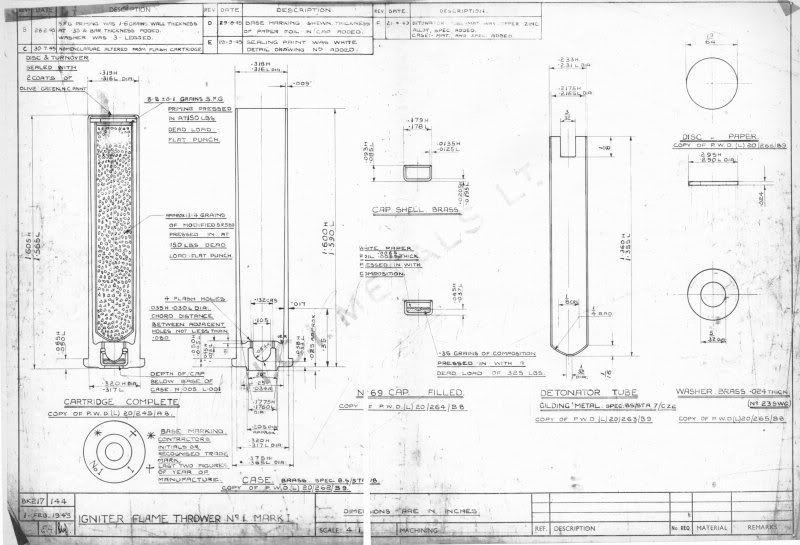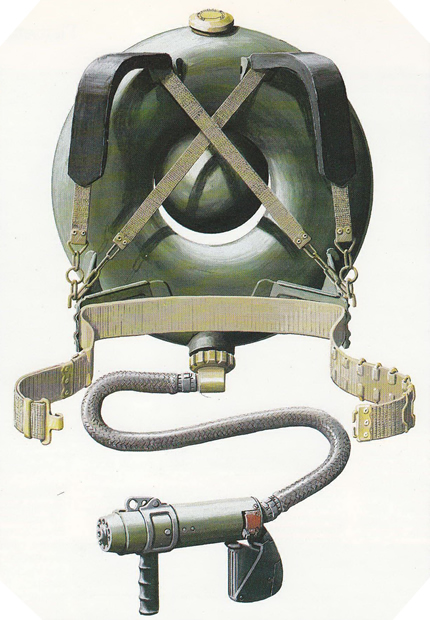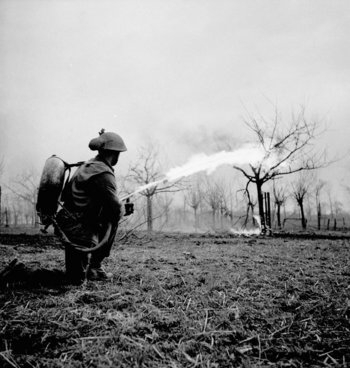Development of what was to become officially known as the Flame-Thrower, Portable, No. 2 Mk I, began during 1941. lt appears to have been influenced by the German Flammenwerfer 40, but the basic design of any portable flamethrower is fixed by physical constraints. This results from the fact that for a vessel that has to contain gas at high pressure the sphere is the best possible shape. On a flamethrower the fuel tank has to contain as much fuel as possible within as small a volume as can be managed. These design criteria virtually dictate the shape of the resultant equipment, i.e. a central sphere with a fuel tank having a circular cross-section wrapped around it. This produces the classic shape which gave the British equipment its Lifebuoy nickname, a name that stuck.
The first pilot model was ready by mid-1942 and a production order soon followed, despite the fact that the usual series of troop and other trials had not been completed. This was unfortunate, for after only a short time in service the Lifebuoy began to demonstrate a number of serious defects, many of them caused by hurried manufacture of the complex shape of the tanks. As always, ignition proved to be somewhat unreliable, and the position of the fuel valve under the tanks proved to be awkward to use in action. As a result the first production run of the Lifebuoy, the Mk I was withdrawn and used for training only from mid-1943 onwards. lt was not ‘mill the following year that the improved Flame-Thrower, Portable, No.2 Mk II appeared. lt was this version that the British Army used until the war ended, and for many years after. In appearance there was little to differentiate the Mk l from the Mk ll. The Mk ll was ready for service by June l944, and was used during the Normandy landings and after them, including the campaigns in the Far East. However, the British Army never was really enthusiastic regarding portable flamethrowers and decided that not many would be required.
Production of the Mk ll ended as early as July 1944, after 7,500 had been made. Even the Mk ll proved to be generally unreliable as it depended on a small battery to ignite the flame, and in wet conditions or after even a short period of use the battery often failed. The old production problem of quality control was carried over as well, and as always the troops complained about the weight. The official solution was to produce a smaller device known as the Ack-Pack which weighed 21.8 kg (48 lb), not for use in Europe but for possible use in the Far East. ln any event the Ack-Pack was given such a low development priority that it was not produced until after the war was over. So ended the rather unfortunate Lifebuoy proiect.
proiect.







 These four specimens are all South African manufactured
These four specimens are all South African manufactured




Left Photo: Lance-Corporal J.E. Cunningham of The Essex Scottish Regiment practices firing a Lifebuoy flamethrower near Xanten, Germany, 10 March 1945. LAC Photo. (https://www.canadiansoldiers.com)
